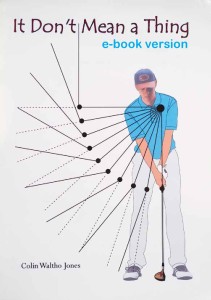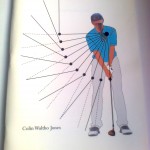Practising. The best practise is to play. If you are playing enough then you don’t need to practise. Practise should be used to try things out (like the stretch at the top of the backswing). Rules for practise:
- 20 minutes maximum. Never break this rule because it is simply not possible to switch on your sub-conscious for any longer. That’s why practise sessions deteriorate and leave you a little dissatisfied.
- Only take one club. Never break this rule because it stops you hitting balls just for the sake of hitting them.
- Go to the session with a specific aim and stick to it.
- Hit EVERY ball with full commitment to the purpose of the session and using the method fully, which means . . .
- Do NOT hit practise balls to warm up. Warm up by stretching and swinging.
———————————————————————————
Practise – Being good at golf is about successfully applying a specific force to a golf ball, shot after shot after shot. On the practice ground it is impossible to replicate the circumstances of the shots you face in a round. Therefore, you should practise golf by playing it (and by following my method of looking for “timing” it is inevitable that playing golf will improve your golf). In your particular case, I think the practise range is a bad idea because it indulges your need to analyse; whereas, in my view, you need to practise going from shot to shot to shot trying to find the best pendulumic rhythm you can – from 1st tee to 18th green.
————————————————————————————
Practising – My view on practising in your particular case (but this probably applies to most golfers) is that it fails on two important levels. First, it reinforces your belief that there are mechanical bits of your game that you can fix by practising. This is wholly unhelpful simply because it encourages you to allow your logical, reasonable, fact-driven conscious brain to dominate the act of hitting golf balls accurately. My discovery is that the application of accurate force is achieved by normal subconscious processes that have evolved to exploit the fact that our jointed limbs can swing and can therefore harness the wholly predictable force of gravity. The challenge of games is to allow those natural abilities to work as they were designed by evolution to work. This involves consciously getting the conscious to NOT interfere with the subconscious process but rather to make it HELP the subconscious process.
For example, the first step in the method is to . . .
—————————————————————————-
Practising –I need to clear a few things up about my attitude to practising.
- I think it is a bad idea for you to practise because it reinforces your strong belief that your swing can be improved through repetition and analysis.
- To practise playing golf one needs to play golf, which you do. This is because playing golf successfully depends on you locating your “timing” and then carrying that “rhythm” from shot to shot through the round. (By “shot to shot” I mean consecutive shots, not from one 7-iron to the next time you have to play a 7-iron.). This is only possible out on the course, preferably in a competitive situation. Only on the course inside a competition is it possible to replicate the conditions that affect a golfer’s ability to hit successful shots. Practising on a range only improves your ability to practise on a range.
- I think that what you benefit from is “warming-up”. I think warming-up is a very good idea because of the propensity it has to hasten relaxed muscles. If warming-up is undertaken with the express purpose of starting that day’s search for the elusive “timing” then so much the better. My suggestion is that you warm up by hitting 20 balls. Randomise your choice of club for each shot so that the exercise mimics real golf. Aim to simply locate your “timing” and, when you find it, to take the rhythm to the next shot. Stop after 20 balls and move to the practice green and hit 20 putts with the “rhythm” you have located on the range. Avoid getting attached to the outcome of the shots – particularly the putts – and simply concentrate on rekindling the memory of the rhythm (pendulumic) of the last perfectly timed shot you can remember.
- Only go on the range in order to warm up for that day’s golf. Do not go there any other time. If you really feel the urge to practise then play a few holes but play them completely differently to how you would normally play them. For example, take a 3-iron off all the par 3 tees.


